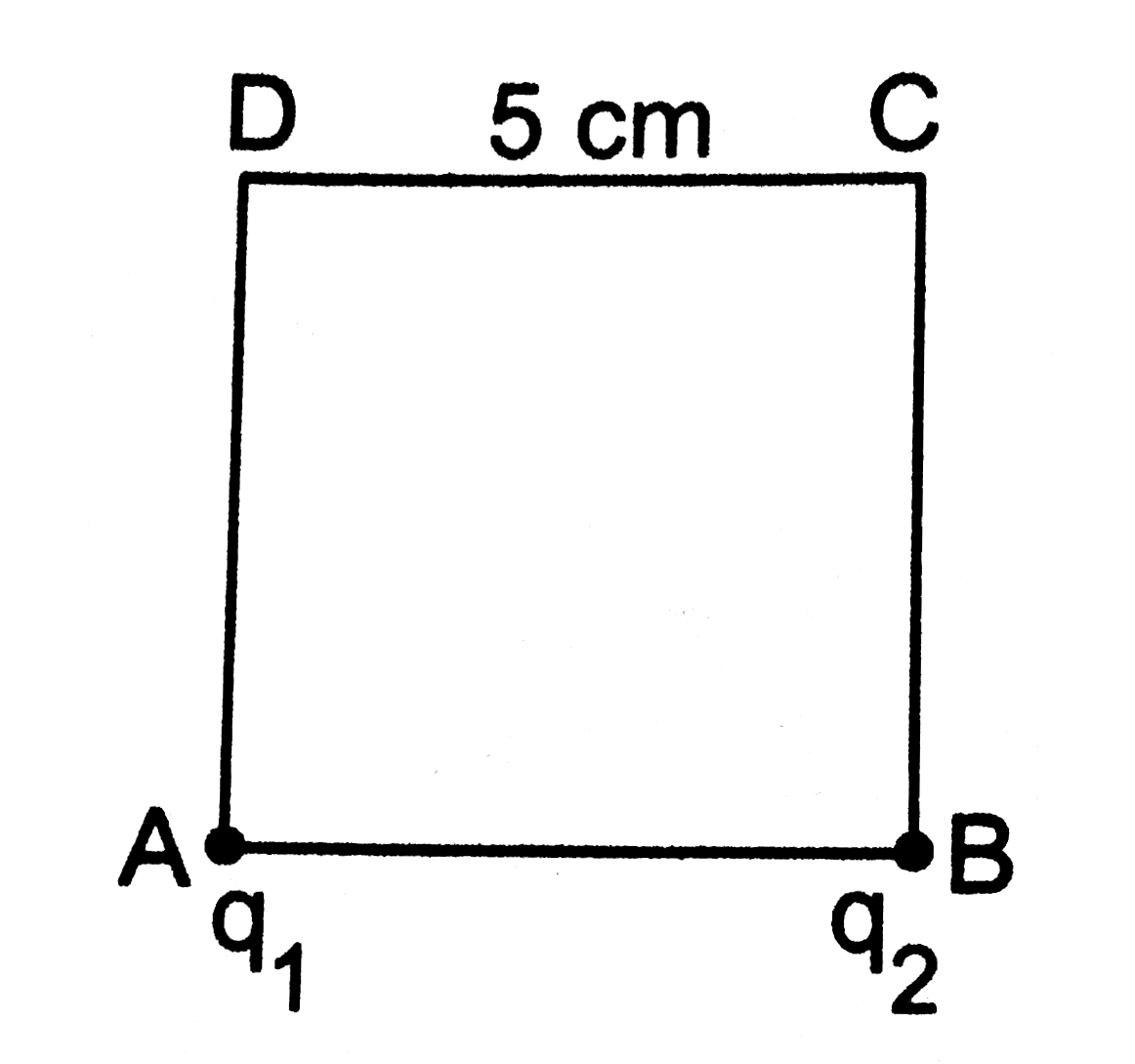Charges 5.0×10−7C,−2.5×10−7Cand1.0×10−7C are
held fixed at the three corners A, B, C of equilateral triangle of side 10cm respectively. Find the electric force on the charge at C due to the rest two.
To solve the problem of finding the electric force on the charge at point C due to the charges at points A and B, we will follow these steps:
Step 1: Identify the charges and their positions
- Charge at A (QA) = 5.0×10−7C
- Charge at B (QB) = −2.5×10−7C
- Charge at C (QC) = 1.0×10−7C
- The side of the equilateral triangle (r) = 10 cm = 0.1m
Step 2: Calculate the force on charge C due to charge B (F1)
Using Coulomb's Law, the force F between two charges is given by:
F=14πϵ0|Q1Q2|r2
Where:
- ϵ0=8.85×10−12C2/(N⋅m2)
For the force F1 due to charge B on charge C:
F1=14πϵ0|QB⋅QC|r2
Substituting the values:
F1=9×109N⋅m2/C2⋅|(−2.5×10−7)⋅(1.0×10−7)|(0.1)2
Calculating this gives:
F1=9×109⋅2.5×10−140.01=2.25×10−2N
This force is attractive since charge B is negative and charge C is positive.
Step 3: Calculate the force on charge C due to charge A (F2)
For the force F2 due to charge A on charge C:
F2=14πϵ0|QA⋅QC|r2
Substituting the values:
F2=9×109N⋅m2/C2⋅|(5.0×10−7)⋅(1.0×10−7)|(0.1)2
Calculating this gives:
F2=9×109⋅5.0×10−140.01=4.5×10−2N
This force is repulsive since both charges A and C are positive.
Step 4: Determine the resultant force on charge C
The angle between the forces F1 and F2 is 120∘ (since it is an equilateral triangle). The resultant force F can be calculated using the formula:
F=√F12+F22+2⋅F1⋅F2⋅cos(120∘)
Substituting the values:
F=√(2.25×10−2)2+(4.5×10−2)2+2⋅(2.25×10−2)⋅(4.5×10−2)⋅(−0.5)
Calculating each term:
- F12=5.0625×10−4
- F22=20.25×10−4
- 2⋅F1⋅F2⋅cos(120∘)=−10.125×10−4
Now, summing these:
F=√5.0625×10−4+20.25×10−4−10.125×10−4=√15.1875×10−4≈3.89×10−2N
Final Answer
The electric force on the charge at C due to the charges at A and B is approximately:
F≈3.89×10−2N
---
- Charge at A (QA) = 5.0×10−7C
- Charge at B (QB) = −2.5×10−7C
- Charge at C (QC) = 1.0×10−7C
- The side of the equilateral triangle (r) = 10 cm = 0.1m
Using Coulomb's Law, the force F between two charges is given by:
F=14πϵ0|Q1Q2|r2
Where:
- ϵ0=8.85×10−12C2/(N⋅m2)
F1=14πϵ0|QB⋅QC|r2
Substituting the values:
F1=9×109N⋅m2/C2⋅|(−2.5×10−7)⋅(1.0×10−7)|(0.1)2
Calculating this gives:
F1=9×109⋅2.5×10−140.01=2.25×10−2N
This force is attractive since charge B is negative and charge C is positive.
For the force F2 due to charge A on charge C:
F2=14πϵ0|QA⋅QC|r2
Substituting the values:
F2=9×109N⋅m2/C2⋅|(5.0×10−7)⋅(1.0×10−7)|(0.1)2
Calculating this gives:
F2=9×109⋅5.0×10−140.01=4.5×10−2N
This force is repulsive since both charges A and C are positive.
The angle between the forces F1 and F2 is 120∘ (since it is an equilateral triangle). The resultant force F can be calculated using the formula:
F=√F12+F22+2⋅F1⋅F2⋅cos(120∘)
Substituting the values:
F=√(2.25×10−2)2+(4.5×10−2)2+2⋅(2.25×10−2)⋅(4.5×10−2)⋅(−0.5)
Calculating each term:
- F12=5.0625×10−4
- F22=20.25×10−4
- 2⋅F1⋅F2⋅cos(120∘)=−10.125×10−4
F=√5.0625×10−4+20.25×10−4−10.125×10−4=√15.1875×10−4≈3.89×10−2N
The electric force on the charge at C due to the charges at A and B is approximately:
F≈3.89×10−2N
Topper's Solved these Questions
- ELECTRIC FIELD AND POTENTIALBOOK - HC VERMA ENGLISHCHAPTER - ELECTRIC FIELD AND POTENTIALEXERCISE - Exercises
75 Videos
- ELECTRIC FIELD AND POTENTIALBOOK - HC VERMA ENGLISHCHAPTER - ELECTRIC FIELD AND POTENTIALEXERCISE - question for short answer
14 Videos
- ELECTRIC FIELD AND POTENTIALBOOK - HC VERMA ENGLISHCHAPTER - ELECTRIC FIELD AND POTENTIALEXERCISE - Objective 2
7 Videos
- ELECTRIC CURRENT THROUGH GASESBOOK - HC VERMA ENGLISHCHAPTER - ELECTRIC CURRENT THROUGH GASESEXERCISE - Short answer
6 Videos
- ELECTROMAGNETIC INDUCTIONBOOK - HC VERMA ENGLISHCHAPTER - ELECTROMAGNETIC INDUCTIONEXERCISE - Questions for short answer
9 Videos
Similar Questions
Three equal charges, 2.0×10−6 C each, are held fixed at the three corners of a square of side 5 cm. find the Coulomb force experienced by one of the charges due to the rest two.
View SolutionFour point charge of +10−7C,−10−7C,−2×10−7Cand+2×10−7C are placed respectively at the corners A, B, C, D of a 0.05m square. Find the magnitude of the resultant force on the charge at D.
View SolutionFour equal charges 2.0×10−6C each are fixed at the four corners of a squae of side 5 cm. Find the coulomba force eperienced by one of the charges due to the rest three.
View SolutionThree identical charges, each having a value 1.0×10−8C, are placed at the corners of an equilateral triangle of side 20 cm find the electric field and potential at the centre of the triangle.
View SolutionElectric charge of 1μC,−1μC and 2μC are placed in air at the corners A, B and C respectively of an equilateral triangle ABC having length of each side 10 cm. The resultant force on the charge at C is
View Solutioncharges 2.0×10−6C and 1.0×10−6C are placed at. corners A and B of a squae of side 5.0cm as shown in. figure .how much work will be done against. the electric field in moving a charge of 1.0 xx 10^(-6) C from. C to D?.

View SolutionThree equal charges, each having a magnitude of. 2.0×10−6C, are placed at the thre corners of a right. angled triangle of sides 3 cm, 4cm and 5 cm. find the force (in magnitude) on the charge at the right angled
View SolutionCharges of +103×10−9C are placed at each of the four corners of a square of side 8cm. The potential at the intersection of the diagonals is
View SolutionThree points charges of 1C,2Cand3C are placed at the corners of an equilateral triangle of side 100 cm. Find the work done to move these charges to the corners of a similar equilateral triangle of side 50 cm.
View SolutionThree points charges of 1C,2Cand3C are placed at the corners of an equilateral triangle of side 100 cm. Find the work done to move these charges to the corners of a similar equilateral triangle of side 50 cm.
View Solution
